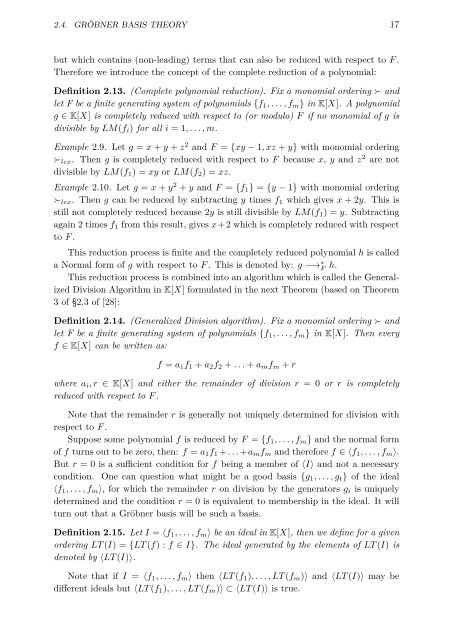link to my thesis
link to my thesis
link to my thesis
Create successful ePaper yourself
Turn your PDF publications into a flip-book with our unique Google optimized e-Paper software.
2.4. GRÖBNER BASIS THEORY 17<br />
but which contains (non-leading) terms that can also be reduced with respect <strong>to</strong> F .<br />
Therefore we introduce the concept of the complete reduction of a polynomial:<br />
Definition 2.13. (Complete polynomial reduction). Fix a monomial ordering ≻ and<br />
let F be a finite generating system of polynomials {f 1 ,...,f m } in K[X]. A polynomial<br />
g ∈ K[X] is completely reduced with respect <strong>to</strong> (or modulo) F if no monomial of g is<br />
divisible by LM(f i ) for all i =1,...,m.<br />
Example 2.9. Let g = x + y + z 2 and F = {xy − 1,xz+ y} with monomial ordering<br />
≻ lex . Then g is completely reduced with respect <strong>to</strong> F because x, y and z 2 are not<br />
divisible by LM(f 1 )=xy or LM(f 2 )=xz.<br />
Example 2.10. Let g = x + y 2 + y and F = {f 1 } = {y − 1} with monomial ordering<br />
≻ lex . Then g can be reduced by subtracting y times f 1 which gives x +2y. This is<br />
still not completely reduced because 2y is still divisible by LM(f 1 )=y. Subtracting<br />
again 2 times f 1 from this result, gives x+2 which is completely reduced with respect<br />
<strong>to</strong> F .<br />
This reduction process is finite and the completely reduced polynomial h is called<br />
a Normal form of g with respect <strong>to</strong> F . This is denoted by: g −→ ∗ F h.<br />
This reduction process is combined in<strong>to</strong> an algorithm which is called the Generalized<br />
Division Algorithm in K[X] formulated in the next Theorem (based on Theorem<br />
3 of §2.3 of [28]:<br />
Definition 2.14. (Generalized Division algorithm). Fix a monomial ordering ≻ and<br />
let F be a finite generating system of polynomials {f 1 ,...,f m } in K[X]. Then every<br />
f ∈ K[X] can be written as:<br />
f = a 1 f 1 + a 2 f 2 + ...+ a m f m + r<br />
where a i ,r ∈ K[X] and either the remainder of division r =0or r is completely<br />
reduced with respect <strong>to</strong> F .<br />
Note that the remainder r is generally not uniquely determined for division with<br />
respect <strong>to</strong> F .<br />
Suppose some polynomial f is reduced by F = {f 1 ,...,f m } and the normal form<br />
of f turns out <strong>to</strong> be zero, then: f = a 1 f 1 +...+a m f m and therefore f ∈〈f 1 ,...,f m 〉.<br />
But r = 0 is a sufficient condition for f being a member of 〈I〉 and not a necessary<br />
condition. One can question what might be a good basis {g 1 ,...,g t } of the ideal<br />
〈f 1 ,...,f m 〉, for which the remainder r on division by the genera<strong>to</strong>rs g i is uniquely<br />
determined and the condition r = 0 is equivalent <strong>to</strong> membership in the ideal. It will<br />
turn out that a Gröbner basis will be such a basis.<br />
Definition 2.15. Let I = 〈f 1 ,...,f m 〉 be an ideal in K[X], then we define for a given<br />
ordering LT (I) ={LT (f) :f ∈ I}. The ideal generated by the elements of LT (I) is<br />
denoted by 〈LT (I)〉.<br />
Note that if I = 〈f 1 ,...,f m 〉 then 〈LT (f 1 ),...,LT(f m )〉 and 〈LT (I)〉 may be<br />
different ideals but 〈LT (f 1 ),...,LT(f m )〉⊂〈LT (I)〉 is true.

















